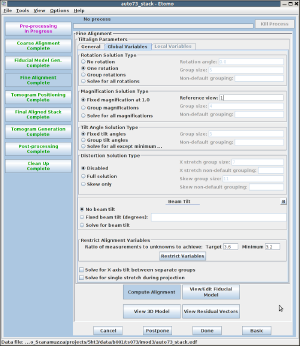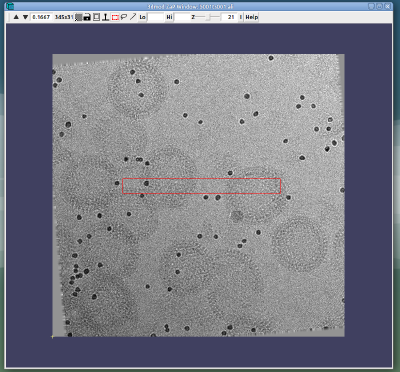Considerations for tilt series alignment in IMOD
When doing the tilt series alignment in IMOD, we strongly recommend to consider the following points in order to reach the best possible results.
Contents
Alignment parameters
To avoid overfitting, the tilt parameters should describe a rigid body transformation, i.e., we only solve for the parameter “one rotation”. The parameter selection should look as shown in the screenshot below. Introduce new parameters (e.g., "group rotations" or "group magnifications") only in the case where this is the only way to significantly improve the tomogram quality.
Residual fixing
In the “residual fixing” step in IMOD, the residuals should be fixed individually but only in a way that makes sense, i.e., the centers of the model (green circles) should always be in the center of the gold beads, even if the residual (red arrow) points somewhere else. This can be achieved by manually moving/correcting the green circles (right mouse click) if necessary. Suggestion: The “threshold for residual report“ can be set to 3 in the beginning and, after correcting the residuals as described, it can be lowered to 2. After computing a new alignment and fixing the residuals again it can be lowered even further to 1 or 0.5.
Removing outlier beads
If there are outlier beads in your model that keep having large residuals, no matter how well centered the model is, they can be removed from the model. However, this should only be done in extreme cases. Make sure you keep enough gold beads in your final model (absolute minimum 5, ideally 10-15 or as many as behave well).
Alignment error
The alignment error should preferably be below 2 pixels and in the best cases below 1 pixel. However, this should not be forced. As said before, keep the points of the model on the center of the beads and keep enough gold beads in the model. It can very well be that some tomograms simply cannot be aligned better.
Alignment quality
Once you are satisfied with the alignment you can quickly check the alignment quality visually by confirming that the beads are moving perfectly horizontal throughout the tilts. Drawing a red rectangle with the corresponding tool in 3dmod can be helpful as a visual guide:
Tomogram quality
Another way to check the alignment quality is by visually inspecting the beads in the final tomogram. This is described in more detail here.

